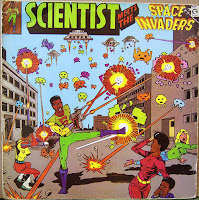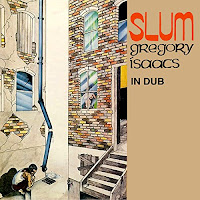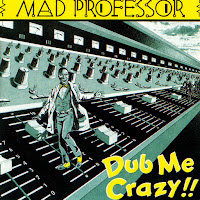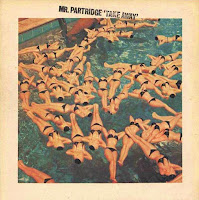Given recent world events you wouldn’t be blamed for
wanting to disappear to another space and time. Somewhere free from
megalomaniac billionaires and where Prince, Bowie and Lemmy where still
producing the goods. I think I’m still in the denial stage of grief about 2016
as a year. Escape isn’t an option of course and unfortunately you just have to
deal with the hand you are dealt.
I’ve been trying to clear some mental space to work in lately. It’s good therapy. My little guys have been leaving me the sketches for some new stuff and I need to have a nice big barn to play in. The easiest way I found of taking your head to another space and time is to immerse yourself in dub. Some might call it escapist, I call it a holiday. And not just in the Jamaican sense of a holiday, (although the best dub obviously has that connecting flight), I mean an otherworldly holiday. The best dub will take you anywhere you want to go. When I listen to serious dub I often find myself wandering in a nocturnal forest where the trees have lost their leaves and a distant city provides the only source of light and noise. I’ve got no idea why – I don’t analyse stuff like that. If it’s good to you why fight it.
Now I know what you are thinking, and no, you don’t have to hit the herbal highway to go places with dub. Legendary dub master King Tubby never touched the stuff when he was working in his studio. The same can’t be said for Lee Perry, but then he was on a planet of his own to start with. What most of the early dub masters had in common was a root in DIY electronics. They were studio technicians interested in manipulating sound with home made devices. They also happened to be in an environment where they largely had the freedom to make their own rules. Being very good at what they did didn’t do any harm either.
I’ve been trying to clear some mental space to work in lately. It’s good therapy. My little guys have been leaving me the sketches for some new stuff and I need to have a nice big barn to play in. The easiest way I found of taking your head to another space and time is to immerse yourself in dub. Some might call it escapist, I call it a holiday. And not just in the Jamaican sense of a holiday, (although the best dub obviously has that connecting flight), I mean an otherworldly holiday. The best dub will take you anywhere you want to go. When I listen to serious dub I often find myself wandering in a nocturnal forest where the trees have lost their leaves and a distant city provides the only source of light and noise. I’ve got no idea why – I don’t analyse stuff like that. If it’s good to you why fight it.
Now I know what you are thinking, and no, you don’t have to hit the herbal highway to go places with dub. Legendary dub master King Tubby never touched the stuff when he was working in his studio. The same can’t be said for Lee Perry, but then he was on a planet of his own to start with. What most of the early dub masters had in common was a root in DIY electronics. They were studio technicians interested in manipulating sound with home made devices. They also happened to be in an environment where they largely had the freedom to make their own rules. Being very good at what they did didn’t do any harm either.
Commercially dub is a non-starter. It works best in a
live situation. It started out as an add-on to the top hits of the day played
at Sound System parties in Jamaica. People wanted to hear an extended groove so
they could dance it out some more. That completed, the DJ would talk/sing over
the track to take it to wherever the crowd wanted it to go. That gave rise to
the whole toaster genre in Jamaican music. Basically a direct parallel to the
first rappers at US block parties. The root of it all goes back to the studio
and the electronic wizardry applied to turn the rhythm track into a stand-alone
piece of music. Let’s face it 3-4 minutes of bass and drums would be nothing
without some added highlights, no matter how cool the bassline is.
The first dub LPs were pretty basic affairs along the
lines described above. That was until the aforementioned King Tubby and Lee
Perry began developing their studio techniques on the rhythm tracks they had
open access to in their studios. Pretty soon dub versions were the essential
companion to the standard commercial release for any artist’s work, and
toasters like I-Roy, Big Youth and U-Roy became established as artists in their
own right.
There is enough classic dub available on Youtube to keep
you going for the rest of your life. A lot of it consists of vinyl rips off
scratchy copies of rare, long out of print LPs, but that isn’t a problem. It
does highlight the need to look after your vinyl and get a decent turntable
though, but that’s another matter. Start searching on King Tubby, Scientist,
Prince Jammy and Lee Perry and go from there. You’ll soon notice that each dub
master has their own signature sound that’s as recognisable as a fingerprint.
I hate the concept of ‘the best’, but my favourite dub LP
is Slum which features Gregory Isaacs tracks dubbed by Prince Jammy. It’s filed
as a Gregory Isaacs LP but his voice hardly ever appears across any of the ten
tracks. It’s a brilliant piece of music on its own because of the intricate
balance between the studio effects alongside the original tunes and brief vocal
snatches. It’s more than simply dub in other words. Lee Perry uses a similar
approach, but his works are much denser and less focussed, and his output is so
vast it’s hard to know where to start. Scientist and King Tubby are strictly
dub. Their dubs are what people think of first when they think of dub as a
concept. King Tubby came first but Scientist took it further.
The influence of reggae on the British punk movement in
the late 70s is pretty well documented and it’s safe to say it was a symbiotic
relationship. The Clash and The Ruts took to it wholeheartedly both musically
and culturally. So did The Slits but they were horrid. Others watered it down
but managed to produce some worthwhile stuff. But what of dub in all this?
Well, it did make it across to Britain too, but its influence wasn’t as far
reaching. Its most obvious influence, outside of local reggae
outfits, came out in groups like PiL and the Pop Group with a
stripped down bass and drums approach to song writing, but there were only
really a couple of Jamaican-style British dub masters. Of these Mad Professor
is the most prolific, producing a staggering number of LPs over a long period
of time, and turning dub into live performance while he was at it. His take on
dub is genius along the lines of the Slum LP above – adding as much new stuff
as he took away to make each track a new composition in what’s almost a jazz
style. Check out any of the twelve volumes of his Dub Me Crazy series to see
what I mean. The work of Denis Bovell with dub poet Linton Kwesi Johnston is
also essential. This takes toasting into slightly more serious territory, but
still delivers the goods at the bottom end.
I'm going to end this very scholarly post with XTC.
‘Why?’ I hear you ask. The reggae influence in XTC’s sound is limited to a
couple of singles and some LP tracks, and it’s often so well disguised its
unrecognisable, so why bother mentioning them here? Well, they are one of my
favourite bands for one reason, but also because of a single side project
completed by front man Andy Partridge in 1980 that uses dub principles to
produce completely new compositions from mix ups of songs from their first
three albums. Andy’s Take Away/Lure of Salvage is a real gem. Why more bands
haven’t followed this course is a real mystery. Not having the talent could be
one reason, but even Andy never tried to repeat it so perhaps it is just a
solitary stroke of genius. Some of the tracks are better than the originals
they are taken from, like New Broom which openly competes with their classic
single Making Plans for Nigel, and The Rotary that kicks the hell out of its
parent Helicopter. As a landmark of creativity the album stands as a little
island of madness in a vast ocean of blandness. It’s long out of print but it
was released (incompletely) as Explode Together on CD a long time back as an
XTC disc. You need to hear it, and you also need to get the three LPs the
original tracks come from while you are at it. Plus their fourth album Black
Sea just because it’s so good. Did I mention they are one of my favourite
bands? Google some live XTC bootlegs to see why they were one of the most
dynamic live acts ever as well – they’ll be on Youtube. Most everything is.
As with all these posts there is a link back to
Hopkinsville Gobins tracks. Find out why on Amazon, I-Tunes, Spotify,
Deezer
and Google Play, or from any of the purveyors of fine
sounds listed on this site. You can also get your Paypal on at Bandcamp.
Or try before you buy on Soundcloud.
And don’t forget to check out Amerikaemia
while you are at it. There will be a dub version of that coming up on their
next project.





